If you’re looking for a friendly, easy-to-care-for duck, look no further than the Khaki Campbell. This egg-laying expert has what it takes to win your heart.
The Khaki Campbell duck is considered one of the finest, most well-known egg-laying breeds of domestic duck.
So, if you’re aiming to have a more self-sufficient life, this versatile duck may be right up your alley. The Khaki Campbell will provide an abundance of big, healthy eggs or even a tasty roast.
This article will give you an overview of the Khaki Campbell duck, including information about how many eggs and how much meat they produce, what they look like, and how to take care of them.
So, read on if you’re interested in adding a Khaki Campbell to your flock!
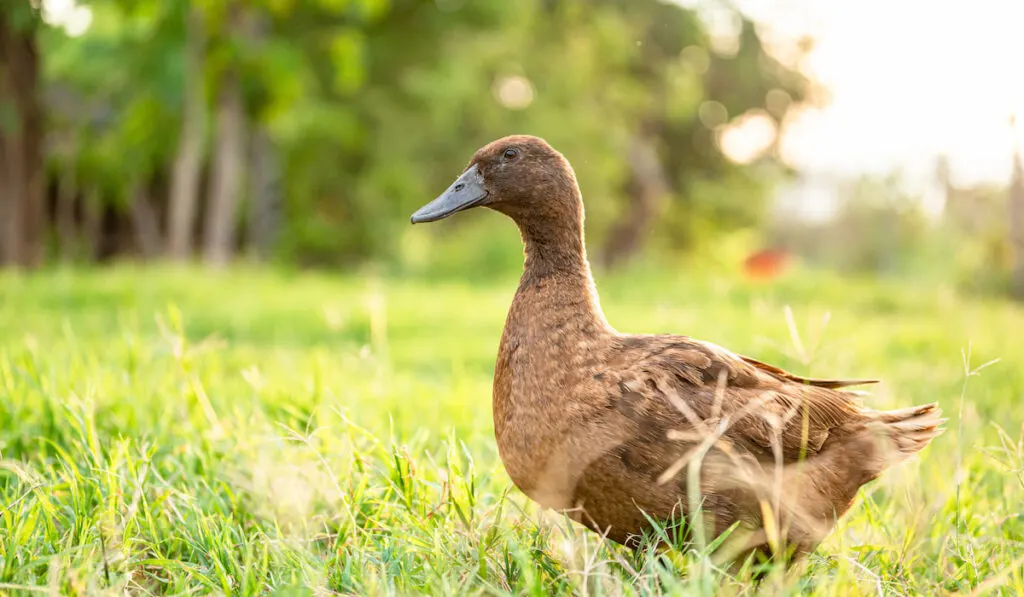
Table of Contents
Khaki Campbell Key Information
| Male Weight: | 3.5 lbs |
| Female Weight: | 4 lbs |
| Breed Class: | Light |
| Use: | Dual-purpose, for both meat and eggs |
| Egg Size: | Large, average 70 grams (2.5 ounces) |
| Egg Production: | 200–350 per year |
| Broodiness: | Average |
| Lifespan: | 10–15 years |
| Climate Tolerance: | Very hardy |
| Color: | Khaki, shades of brown |
| Temperament: | Energetic |
| Flying Ability: | Medium |
| Beginner friendly: | Yes |
Khaki Campbell Origins
The Mother of Khaki Campbell Ducks – Mrs. Adele Campbell
The Khaki Campbell is an old duck breed that came from England.
During the late 1800s, Mrs. Adele Campbell of Gloucestershire bred Campbell ducks in an effort to provide her husband and son with a regular supply of roast duck.
She claimed that the Campbell ducks she was breeding were the offspring of hybrids between the Indian Runner, the Rouen, and the wild duck.
Many duck enthusiasts also believe that the Indian Runner duck served as an important foundation for the Campbell duck.
Back in 1898, Campbell ducks made their debut in Europe.
The Name

Mrs. Campbell after years of effort, was still not quite pleased with her duck’s appearance.
At the time, buff-colored poultry was very popular, so Mrs. Campbell kept crossing her original ducks to try to create a more attractive-colored duck.
She got the idea to call her ducks “Khaki Campbell” when they finally turned the color she desired. She thought their color resembled British uniforms, so she added “Khaki” to their name.
Khaki Campbell Ducks in the United States
The United States imported Khaki Campbell ducks in 1929. And in 1941, they were included in the American Poultry Association’s (APA) American Standard of Perfection.
However, it took many years for those ducks to win the hearts of Americans after they first arrived.
This changed significantly in the 1970s when the number of Khaki Campbells in the United States skyrocketed. There were a few reasons for this.
One was the spread of the “back to the land” ideology.
The second was the increase of Asian immigrants after the Vietnam War. Asian traditional cuisine highlighted dishes made with duck eggs, so their popularity grew.
In 1977, a new line of Khaki Campbells was introduced to the market.
As time passed, the Khaki Campbell duck became one of the world’s most popular breeds of ducks.
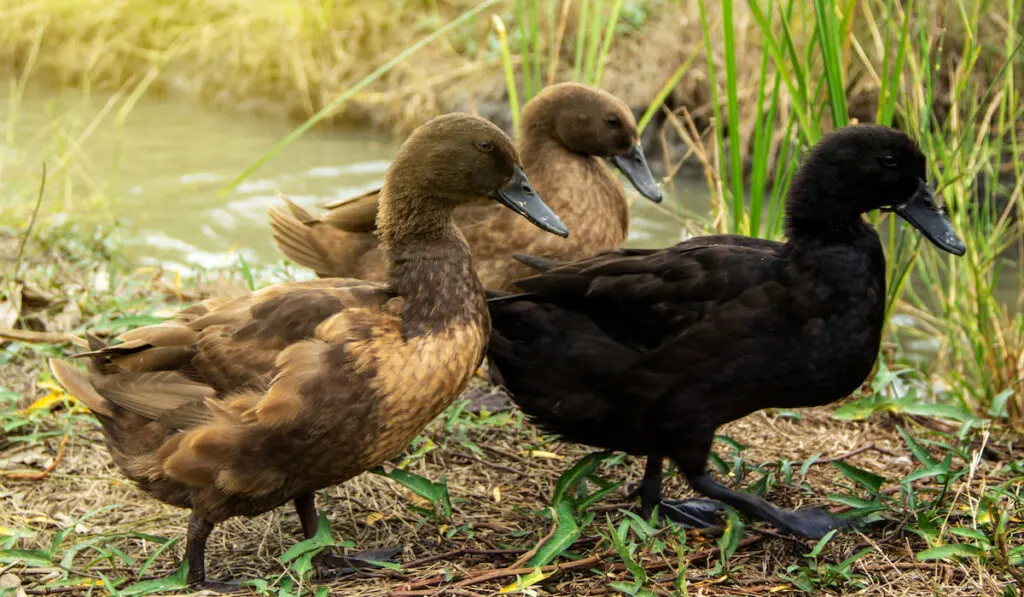
Typical Traits of Khaki Campbell Ducks
The Khaki Campbells’ necks are long, and their bodies are shaped like boats. Their eyes are a deep, rich brown. Legs and feet can range from dark orange to brown in color.
Depending on gender, their bills can be either green or black.
They might have a white to slightly yellowish skin tone based on what they eat.
Khaki Campbells Size
Khaki Campbells are a breed of medium-sized ducks, with males weighing around 3.5 pounds and females about 4 pounds.
Hen Size: 3.5-4 lbs
Drake Size: 4-4.5 lbs
Their typical height ranges from 1.5 to 2 feet, and there is no known Khaki Campbell bantam variety.
Drakes Coloration
The drakes of the Campbell family have a pale brown and khaki coloration.
Their crowns are often a deeper shade of olive green or dark green. Their typical bill color is green with a black tip.
One more characteristic of certain male drakes is a little, curled-up black tail feather.

Hens Coloration
Khaki Campbell females have dark coloration, including dark khaki feathers and wings, while males have lighter hues.
Hens don’t have black patches on their heads, like drakes, and their feathers are more uniform in color.
The hen’s beak is also darker than the beak of the male duck.
Egg Production
People keep Khaki Campbell ducks primarily for their eggs since they are excellent layers. They are known as one of the finest and most popular egg-laying ducks.
Hens usually begin laying eggs between the ages of five and seven months, laying an average of 250 to 350 eggs each year. They lay nonstop all through the year.
Hens typically lay the most eggs during the first two years of their lives and usually keep producing a steady egg supply for around five years.
As the Khaki Campbell gets older, its egg-laying abilities may slow down, but they never stop completely, and the quality of the eggs remains consistent.
On average, these ducks will live for between eight and ten years.
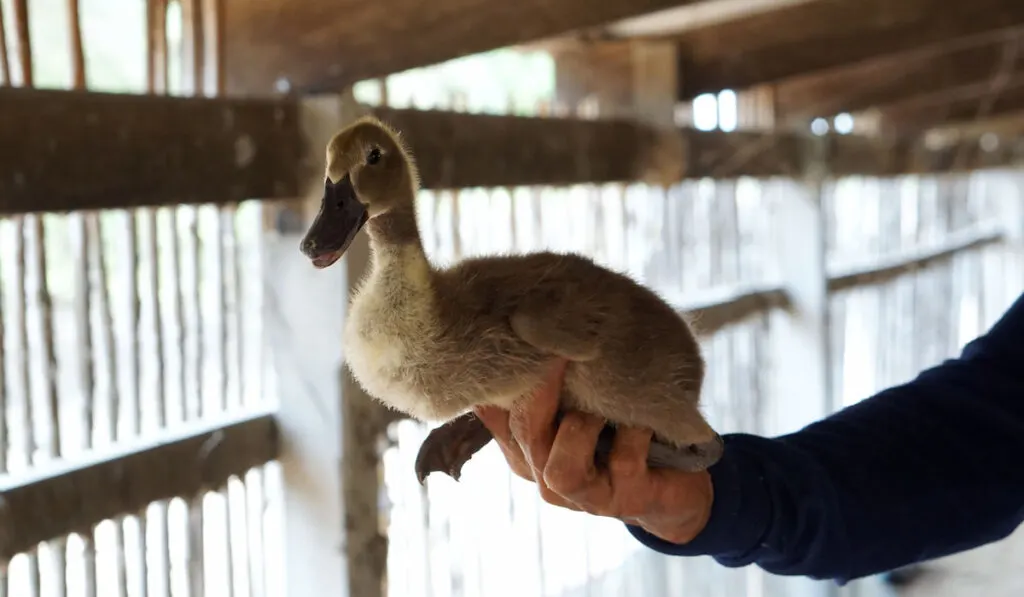
The Khaki Campbell’s Meat
Although ducks of all breeds provide great meat, some breeds stand out from the rest.
Due to their smallish size, Campbells are not popular with people who raise ducks for meat. Regarding taste, the Khaki Campbell is not the best choice either.
In the world of duck meat, the Muscovy duck is often considered the best meat duck due to its exquisite flavor and tender texture.
Nevertheless, Khaki Campbell drakes are sometimes bred specifically for their meat. They reach a mature weight of 5.5 pounds in a short period of time and are an acceptable size for providing a fair supply of meat.
But if you are looking for the most flavorful duck meat, Khaki Campbell probably won’t be your first choice.

Feeding
Khaki Campbells are self-sufficient as they can meet most of their nutritional requirements by foraging.
They enjoy eating garden snails and bug larvae. And if they can get into the pond, they can eat tiny fish, plankton, and aquatic plants.
However, if you don’t let your ducks walk free, you’ll need to give them professionally produced duck food. Khaki Campbell ducks require a high-protein diet with a 16–18% protein content.
Once they reach around three months of age, it is fine to give them chicken feed.
Each day, an adult Khaki Campbell will consume up to 130 grams (4.6 ounces) of food.
In addition to well-balanced meals, you may offer them a variety of snacks. Fruits and vegetables of all kinds are highly recommended as healthy ways to boost vitamin intake.
Make sure your ducks don’t choke on their snacks. Only give them small pieces or crumbles.
Also, ducks drink a lot of water. Make sure that they always have access to clean, fresh water.
Noise Level
As ducks go, Khaki Campbells aren’t exactly famed for their quacking.
As a matter of fact, Khaki Campbell ducks are known for being one of the quieter breeds.
If your Khaki Campbell is hungry or feels threatened, it may quack. However, these noises are not very loud and sound more like a grunt than anything else.
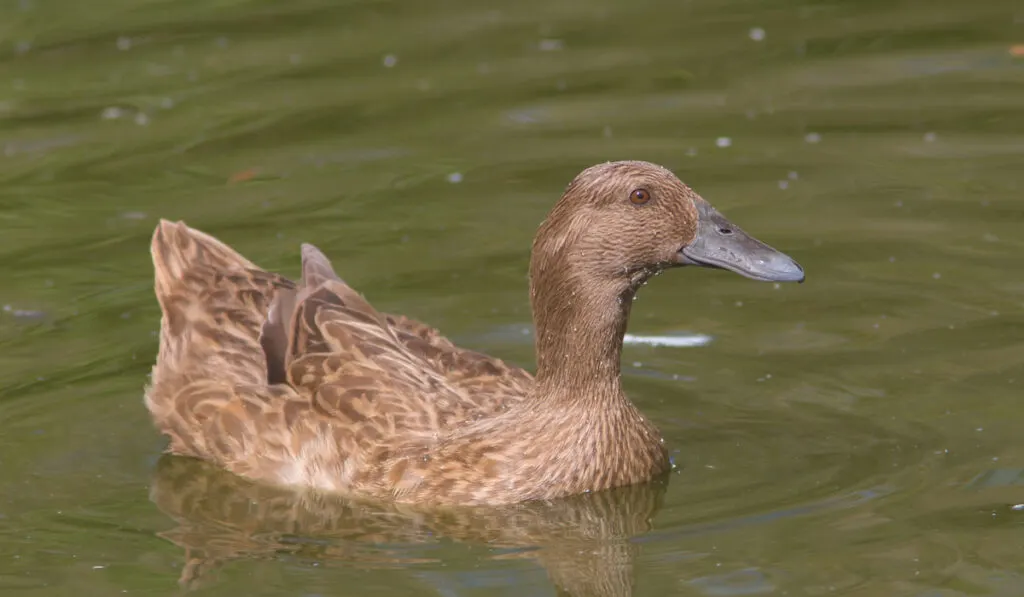
Health Problems
There are no recognized health problems associated with the Campbell duck.
This duck breed has been bred for almost a century; if it were susceptible to serious health problems, it would never have stayed in demand for so long.
Of course, providing extra attention will guarantee the birds’ healthy development and longevity. Vaccinate your birds on schedule and provide them with necessary medications or supplements.
Weather Resistance
The Khaki Campbell breed is tolerant of varying climates as well.
These ducks flourish in environments where the temperature stays far below freezing for an extended period of time.
They can also thrive in hot, humid places that often exceed 100°F (37.7°C).
Duck House
The needs of a duck are very simple. They don’t need a nest box or roosting bars; they just enjoy sleeping on the floor.
A dry, clean spot inside the coop that offers a layer of straw makes for the ideal sleeping spot for them.
The coop should be on the ground or have a low ramp leading up to it.
Put a lot of straw in the house so they can make a nest out of it and curl up in it to feel comfortable.
A good rule of thumb is that each Khaki Campbell requires three square feet of space inside the coop.
Ventilation is the most important factor in the duck’s home. It’s important to ensure the house has enough vents and openings for any extra moisture to escape.
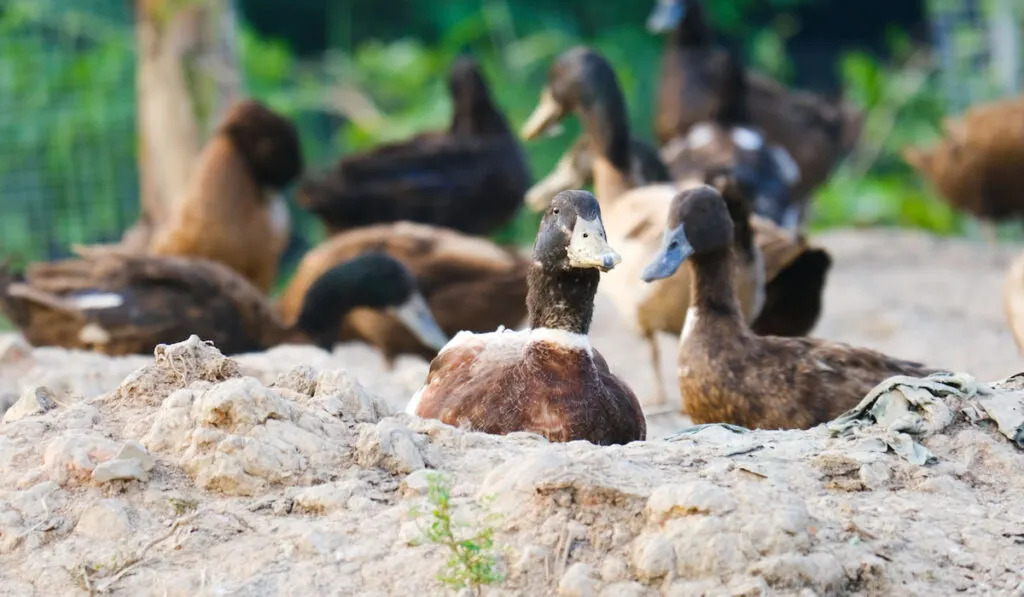
Outside Living
Khaki Campbell’s wild ancestry makes them excellent foragers. They do best when given plenty of room to wander.
Khaki Campbells, like other ducks, appreciate access to water where they may swim or cool down during the hot summer months.
Therefore, if no natural pond is available, you should set up a small body of water for them.
A plastic baby pool or an old bathtub might serve as a pool for them. Make sure there is enough space for your ducks, so they don’t fight over it.
Khaki Campbell Ducks Flying Abilities
Because of their medium size and lightweight, Khaki Campbell ducks can make jumps and flights up to 4 feet in height.
However, they are highly domesticated ducks that will normally only take flight if they are scared or trying to escape potential danger.
Usually, Khaki Campbell ducks don’t fly at all or only flap their wings enough to get off the ground.
But if you want to be sure that your ducks won’t fly, you can clip their wings. This will stop your duck from taking off.
Some breeders believe the first adult set of wing feathers should be clipped off of Khaki Campbells between the ages of 6 and 8 weeks.
This makes it more challenging for them to learn how to fly. They will be unable to fly well after having their wings clipped, and consequently, they will give up trying.
However, unless you have a strong reason for keeping your ducks on the ground, you should not clip their wings.
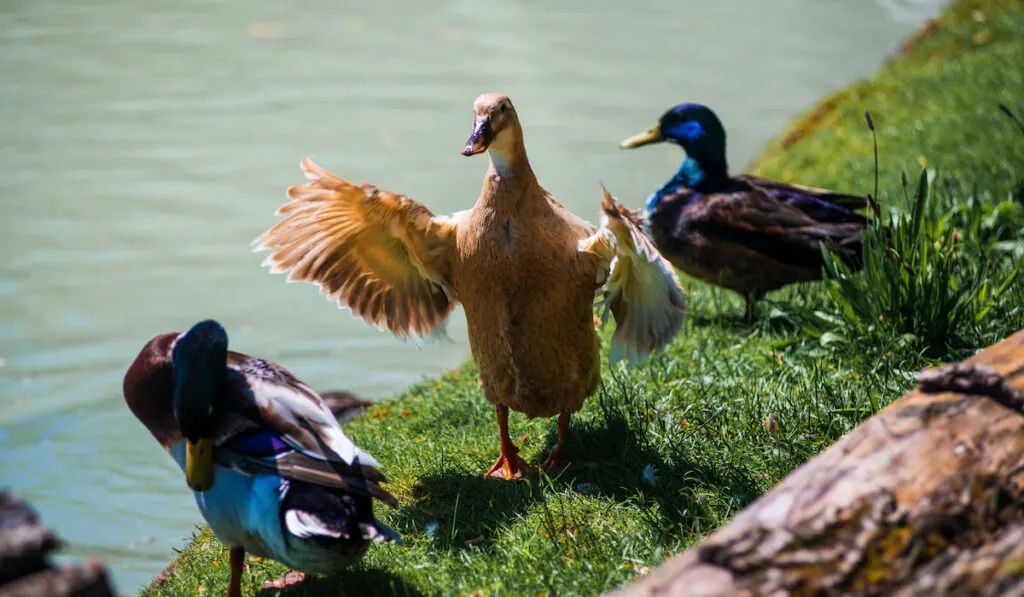
Temperament
Khaki Campbells are intelligent and self-sufficient. These lively ducks adore freedom and free foraging.
They need room to go around and burn off some of their boundless enthusiasm. They are perfect for removing pests and snails from your garden.
When introduced to new people, animals, or environments, the Khaki Campbell Duck often shows anxiety or timidness.
They need some time to adjust to their new home and human keepers, but eventually, they become a harmonious part of the flock.
When raised with chickens or other pets from a young age, they tend to bond with their mates and stay close to them for the rest of their lives.
Breeding
The Khaki Campbell duck has a reputation for being a naturally good breeder.
They won’t have much trouble reproducing as long as you maintain a healthy male-to-female ratio in your flock.
Most of the time, one male is enough to mate with between eight and ten females.
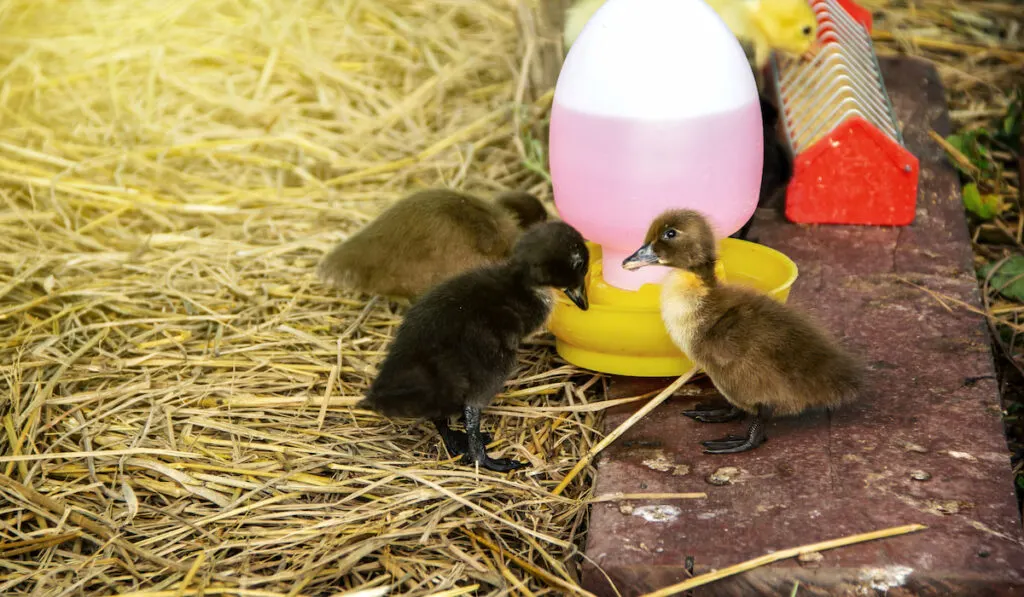
Ducklings
Most of the time, you will need to incubate Khaki Campbell eggs for them to hatch.
This is due to the fact that Khaki Campbell hens have poor maternal instincts, although they do occasionally go broody with their eggs.
A Khaki Campbell duck egg takes about 28 days to hatch, whether it does so on its own or in an incubator.
As is the case with all other breeds of ducks, you should not let a Khaki Campbell duckling swim in the water until it is at least three weeks to two months old.
When they are very young, ducklings do not yet have the normal body oils that allow them to dry quickly and keep them from becoming chilly.
Final Thoughts
Ducks of the Khaki Campbell breed are among the most common types of farmed ducks kept in the United States.
The capacity of Khaki Campbell ducks to produce high-quality eggs is the primary motivation for most of the people who keep these ducks.
If you are a fan of duck eggs or eggs in general, the Khaki Campbell is the best choice you can make. In fact, when it comes to laying eggs, this duck is far superior to most chicken breeds.
So, if you have a flock of Campbells, you will have fresh duck eggs on your table every day of the year.
In addition to their productivity, Khaki Campbell ducks are robust, lively, and exceptionally resilient.
These self-sufficient ducks are expert foragers and will spend the majority of their time waddling around your property in search of their next meal.
Resources
- https://livestockconservancy.org/heritage-breeds/heritage-breeds-list/khaki-campbell-duck/
- https://petkeen.com/khaki-campbell-duck/
- https://www.metzerfarms.com/articles/AdvantagesOfDucks.pdf
- https://domesticanimalbreeds.com/khaki-campbell-duck-breed-everything-you-need-to-know/
- https://breeds.okstate.edu/poultry/ducks/khaki-campbell-ducks.html?Forwarded=afs.okstate.edu/breeds/poultry/ducks/khakicampbell/index.html/
- https://www.chickensandmore.com/khaki-campbell-duck/
- https://www.thehappychickencoop.com/khaki-campbell-duck-everything-you-need-to-know/
- https://kvk.icar.gov.in/API/Content/PPupload/k0159_16.pdf
